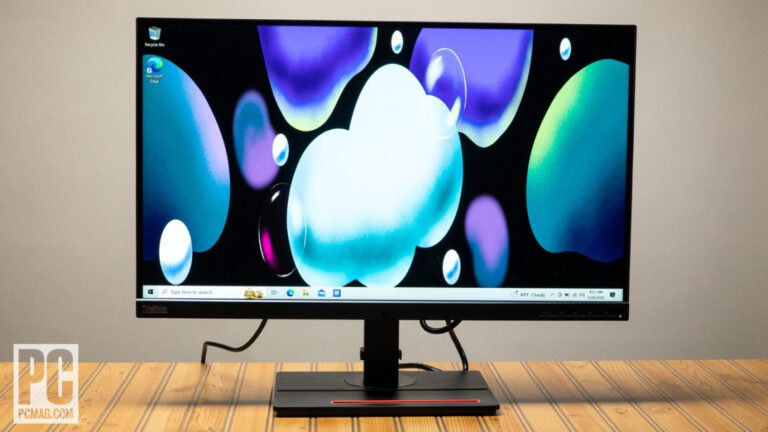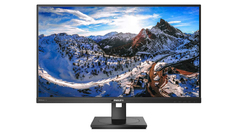
[ad_1]
The Lenovo ThinkVision P27u-20 ($769), a 27-inch productivity monitor, offers more ports than its predecessor the ThinkVision P27u-10—including a pair of Thunderbolt 4 connectors—while keeping the latter’s impressive color accuracy and slightly bettering its ergonomics. The panel’s high resolution makes it good for viewing small text, cramped spreadsheets, or fine detail in diagrams, while its accurate color rendition suits it for working with graphic arts. The P27u-20 is a fine docking-station monitor—it has all the connections you’d usually find in a laptop dock, including the ability to power your computer and connect via Ethernet—but you’ll pay a pretty penny for it.
Copious Connectivity
Not counting its stand, the P27u-20 measures 16.6 by 24.2 by 8.7 inches (HWD) and weighs 17.7 pounds. Its 27-inch in-plane switching (IPS) screen features UHD or 4K (3,840-by-2,160-pixel) resolution at a 16:9 widescreen aspect ratio. Like the P27u-10, the ViewSonic VP2785-4K, and other 27-inch 4K displays, the Lenovo has a pixel density of 163 pixels per inch (ppi). This is higher than the company’s ThinkVision P32u-10, whose pixel density is 138ppi—the larger the screen at the same resolution, the more spread out (or less dense) its pixels are.
Like other IPS monitors, the ThinkVision P27u-20 delivers wide vertical and horizontal viewing angles (rated up to 178 degrees), ensuring accurate color even when seeing the screen from the side or above.

(Credit: Kyle Cobian)
The display’s stand and cabinet are matte black. The top and side bezels are 0.3 inch wide, while the bottom bezel is an inch thick. The deceptively simple stand packs in a full set of ergonomic features. The rectangular base has a depression in front in which you can stash a pen, a stylus, or a thumb drive.
Similar Products

(Credit: Kyle Cobian)
The shaft of the stand extends upward from near the back of the base and meets the cabinet at a hinge that lets you tilt the top of the screen up to 5 degrees toward you or 35 degrees away. You can also pivot the monitor between landscape (horizontal) and portrait (vertical) orientation, swivel the screen up to 45 degrees left or right, and adjust its height by up to 5.3 inches.
The P27u-20’s port selection is above average for a business monitor; in fact, it qualifies as what we’d call a docking-station monitor, with enough connectors to stand in for a laptop docking station. For starters, it has dual Thunderbolt 4 ports, allowing you to daisy-chain a second 4K display; the P32u-10 has two Thunderbolt 3 ports and the P27u-10 only a single USB-C port. This ThinkVision isn’t the first Thunderbolt 4-equipped monitor we’ve encountered—the HP Z32k G3 USB-C Display has a single such port—but they’re still uncommon. The Thunderbolt 4 spec uses a USB-C connector and is backward-compatible with previous Thunderbolt versions as well as all USB standards. The Thunderbolt inbound connection provides up to 100 watts of power delivery to a laptop as well as transferring the video signal and data from the PC.

(Credit: Kyle Cobian)
The P27u-20 also has two HDMI ports, a DisplayPort connector, a hub of four USB 3 ports including one USB-C port with up to 27 watts of power delivery. The ports are downward-facing but relatively easy to access by pivoting the bottom of the monitor toward you from either side.

(Credit: Kyle Cobian)
If your laptop lacks an RJ-45 Ethernet jack and your Wi-Fi is spotty or nonexistent, there’s no need to fret—when your computer’s connected to the P27u-20 you can access a local area network through the monitor’s gigabit Ethernet jack. (The data travels over an upstream data connection to the PC.) The Ethernet link also enables your IT department to perform setup, administrative, and security tasks remotely. Among the network management features supported are PXE (Preboot eXecution Environment), which allows a PC to boot directly from the network, and WoL (Wake on LAN), which enables a computer to be woken remotely from a low-power state.
The onscreen display’s (OSD) menu system is controlled by four physical buttons next to the power button at the right of the bottom bezel. In testing, I used the OSD to set the monitor’s color mode to one of the spaces we test in, such as sRGB, Adobe RGB, or DCI-P3, and the brightness to 100%. The menu system is straightforward, and the front-facing buttons are readable, but they make the OSD harder to navigate than the mini-joystick controller that we see on many productivity and professional monitors nowadays.

(Credit: Kyle Cobian)
Testing the Lenovo ThinkVision P27u-20: Accurate Colors, Solid Brightness
Lenovo says the ThinkVision P27u-20 has a Delta E (dE) of less than 1. Delta E is the difference between the hue of a displayed color and the input the monitor received; the lower the value, the more accurate the color. The figure shown in monitor specs is the average of a large number of individual color readings from across the spectrum. An average below 1 indicates color so accurate that an expert would be unlikely to distinguish any variation between the color on screen and the intended (source) color.

(Credit: Portrait Displays)
I used our standard test gear, consisting of a Klein K-80(Opens in a new window) colorimeter and Portrait Displays Calman 5(Opens in a new window) software, to perform our color accuracy, luminance, and contrast-ratio testing. Out of the box, the P27u-20 turned in an average dE of 1.1 in sRGB (see the chart above) and 1.52 in Adobe RGB (see below), which is a little shy of Lenovo’s claimed accuracy but still excellent. The sRGB score is one of the best we’ve measured, and you can always tweak further if color accuracy is your meat-and-potatoes.

(Credit: Portrait Displays)
In color-gamut coverage, the P27u-20 did well with sRGB, covering 99.6% of that color space. It also did a decent job with Adobe RGB (95.9% coverage) and DCI-P3 (95.2% coverage). It fell short of its rated luminance or brightness of 400 nits (candelas per square meter), turning in a still-bright 337 nits. The monitor carries a DisplayHDR 400 rating and delivered 367 nits in our HDR testing. It also narrowly missed its rated 1,000:1 contrast ratio, with a best result of 912:1 in sRGB.

(Credit: Kyle Cobian)
In addition to our formal testing, I did some ad hoc viewing of selections from our photo suite and some of our usual video clips. Colors in photos looked bright and accurate, with strong contrast in both bright and dark areas. Colors in video looked vivid.
The P27u-20’s two 3-watt speakers have reasonably good audio quality as monitor speakers go. The display lacks a webcam, so it’s not a videoconferencing monitor, but with all the other features it packs in, you may not even notice.
A Color- and Connector-Happy Office Display
The Lenovo ThinkVision P27u-20 is a premium productivity monitor with a high-resolution screen and good color accuracy in both the sRGB and Adobe RGB color spaces. It packs a full set of ergonomic features, including portrait/landscape pivoting, which is handy for photographers viewing vertical images as well as anyone seeking easy access to the downward-facing ports. It has both slightly more ergonomic range and a considerably better array of ports than its predecessor, the P27u-10.

(Credit: Kyle Cobian)
The Editors’ Choice-award-winning Dell UltraSharp 27 4K USB-C Hub Monitor lacks Thunderbolt 4 ports, but its DisplayPort-in and -out connectors support daisy-chaining another 4K panel, and it does have three USB-C ports, one with 90 watts of power delivery. The Dell’s secret weapon is IPS Black, which effectively doubles the contrast ratio of an IPS panel by rendering much deeper shades of black, and it’s also priced about $200 under the ThinkVision P27u-20. But both are terrific monitors that have a lot in common; if your PC supports Thunderbolt 4 or you have the extra cash, you’ll be glad to opt for the Lenovo.
4.0

(Opens in a new window)
(Opens in a new window)
Lenovo’s ThinkVision P27u-20 offers great ergonomics, plenty of ports (including twin Thunderbolt 4), and fine color accuracy, though these high-quality features make it a pricey monitor.
[ad_2]
Source link : https://www.pcmag.com/reviews/lenovo-thinkvision-p27u-20










